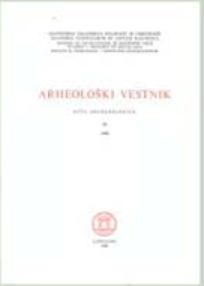Ancient Glass from the Territory of Bosnia and Herzegovina
Abstract
There were during the Roman period numerous types of glass vessels which were primarily used for household purposes. Among the glass vessels we find jugs, bowls, vases, and glasses (pi. IV, fig. 4; pl. V, fig. 1; pl. VII, fig. 2, 3; pl. VIII, fig. 1—5). Besides, in addition to these types of glass vessels we come across other vessels which were possibly used in a funeral ritual or in some other cult or possibly also were related to a particular custom of the private life of certain individuals. This category of glass vessels includes all types of glass vessels used in the embalment (pi. I, fig. 1—9; pl. II, fig. 1—4; pi. Ill, fig. 1—6; pl. IV, fig. 1—3) as well as the little vessels with a suction tube (pl. VI, fig. 2) and those with a figure of Medusa (pl. VI, fig. 1). The present state of investigation indicates that in the territory of Bosnia and Herzegovina ancient glass belonged to urban centres. That is to say that glass could be afforded only by the wealthier Roman citizens. At this time glass probably represented a certain artistic value which was rated quite highly and consequently could be acquired but by the richer strata of the Roman society. This is suggested also by the findings of glass jugs and other vessels in tombs supposed to have belonged to urban settlements like Stolac (Diluntum) (pl. V, fig. 3; pl. VIII, fig. 1—3) and Gradina (Domavia) (pl. VI, fig. 3). Here one might also include Mogorjelo (villa suburbana), possibly belonging to the Roman city of Narona, and the glass from the ancient economic region of Japra93 (pi. V, fig. 4). On the basis of the above mentioned places where glass was found, it seems, that most of the glass articles come from Herzegovina — which fact is probably due to the nearby Narona as a commercial port and to the river Neretva itself as the main traffic route. Also, one should not neglect the commercial impulses of Salona as the capital of the Dalmatian province. Also, due consideration has to be given to the region of big urban settlements in the Roman Pannonia from where the trade of ancient glass was probably extended again and again to the northern parts of the Roman province of Dalmatia. The influence exerted by these areas in the production of glass is to be felt at Jajce94 (pl. VI, fig. 1, 2) and Japra (pl. V, fig. 4), but it seems that it reaches out even into the central areas of the present-day Bosnia and Herzegovina. As regards the dating of glass vessels from the territory of Bosnia and Herzegovina, we can establish the following: a) ancient glass like all kinds of vessels used for embalment at the time when the cult of incineration was predominant comes from the time from the first century to the middle of the third century A. D. b) ancient glass including various types of vessels (jugs, bowls, glasses, and vases) seems to belong to the time of the fourth century A. D., when we find a predominance of the cult of inhumation and late-ancient built tombs of various types. c) ancient glass seen in this light, it seems, points to a continued custom related to the cult of the dead: from the domination of the cult of incineration the custom of supplying for the dead person various articles — including little glass vessels — is continued into the period of the domination of the cult of inhumation in built tombs as well as in tombs belonging to the Christian cult.95 As regards workshops producing glass during the Roman period, of which there were Comparatively a great many, and also as regards their products which were being sold throughout the Roman Empire (and accordingly also in our parts) I would not say more at this moment than point at a possibility such workshops might have been existing also in the territory of Bosnia and Herzegovina. In fact, geological testing and its results show that in the territory under consideration there are rich layers of quartz sand and these might have been used as a raw material for the production of glass. In this respect it is the northern parts of Bosnia which are richer, particularly along the river. According to the geological estimates the best quartz sand is to be found at Kozluk near Zvornik. Other places rich in quartz sand are Prijedor, Tuzla, Busovača, Sanski Most, Pečnik near Modrič, Klokotnica near Doboj, and Bistrica.96 This information on where quartz sand is to be found indicates a possibility that Roman workshops producing glass might have existed also in the territory of Bosnia and Herzegovina. Accordingly, there exist serious arguments that one day we may discover glass workshops — perhaps near the places where quartz sand is to be found or in the bigger urban centres near these places. This might be the case in the area of Domavia near Srebrenica. The workshops in ancient Sirmium probably used the raw material from Kozluk near Zvornik, as the transport along the Drina and Sava was cheap.
Downloads
Downloads
Published
How to Cite
Issue
Section
License

This work is licensed under a Creative Commons Attribution-NonCommercial-ShareAlike 4.0 International License.
Authors guarantee that the work is their own original creation and does not infringe any statutory or common-law copyright or any proprietary right of any third party. In case of claims by third parties, authors commit their self to defend the interests of the publisher, and shall cover any potential costs.
More in: Submission chapter





